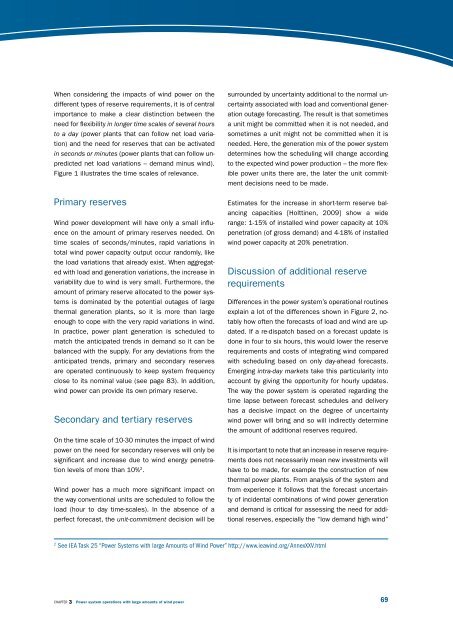Powering Europe - European Wind Energy Association
Powering Europe - European Wind Energy Association
Powering Europe - European Wind Energy Association
Create successful ePaper yourself
Turn your PDF publications into a flip-book with our unique Google optimized e-Paper software.
When considering the impacts of wind power on the<br />
different types of reserve requirements, it is of central<br />
importance to make a clear distinction between the<br />
need for flexibility in longer time scales of several hours<br />
to a day (power plants that can follow net load variation)<br />
and the need for reserves that can be activated<br />
in seconds or minutes (power plants that can follow unpredicted<br />
net load variations – demand minus wind).<br />
Figure 1 illustrates the time scales of relevance.<br />
Primary reserves<br />
<strong>Wind</strong> power development will have only a small influence<br />
on the amount of primary reserves needed. On<br />
time scales of seconds/minutes, rapid variations in<br />
total wind power capacity output occur randomly, like<br />
the load variations that already exist. When aggregated<br />
with load and generation variations, the increase in<br />
variability due to wind is very small. Furthermore, the<br />
amount of primary reserve allocated to the power systems<br />
is dominated by the potential outages of large<br />
thermal generation plants, so it is more than large<br />
enough to cope with the very rapid variations in wind.<br />
In practice, power plant generation is scheduled to<br />
match the anticipated trends in demand so it can be<br />
balanced with the supply. For any deviations from the<br />
anticipated trends, primary and secondary reserves<br />
are operated continuously to keep system frequency<br />
close to its nominal value (see page 83). In addition,<br />
wind power can provide its own primary reserve.<br />
Secondary and tertiary reserves<br />
On the time scale of 10-30 minutes the impact of wind<br />
power on the need for secondary reserves will only be<br />
significant and increase due to wind energy penetration<br />
levels of more than 10% 2 .<br />
<strong>Wind</strong> power has a much more significant impact on<br />
the way conventional units are scheduled to follow the<br />
load (hour to day time-scales). In the absence of a<br />
perfect forecast, the unit-commitment decision will be<br />
chApTEr 3 powersystemoperationswithlargeamountsofwindpower<br />
surrounded by uncertainty additional to the normal uncertainty<br />
associated with load and conventional generation<br />
outage forecasting. The result is that sometimes<br />
a unit might be committed when it is not needed, and<br />
sometimes a unit might not be committed when it is<br />
needed. Here, the generation mix of the power system<br />
determines how the scheduling will change according<br />
to the expected wind power production – the more flexible<br />
power units there are, the later the unit commitment<br />
decisions need to be made.<br />
Estimates for the increase in short-term reserve balancing<br />
capacities [Holttinen, 2009] show a wide<br />
range: 1-15% of installed wind power capacity at 10%<br />
penetration (of gross demand) and 4-18% of installed<br />
wind power capacity at 20% penetration.<br />
Discussion of additional reserve<br />
requirements<br />
Differences in the power system’s operational routines<br />
explain a lot of the differences shown in Figure 2, notably<br />
how often the forecasts of load and wind are updated.<br />
If a re-dispatch based on a forecast update is<br />
done in four to six hours, this would lower the reserve<br />
requirements and costs of integrating wind compared<br />
with scheduling based on only day-ahead forecasts.<br />
Emerging intra-day markets take this particularity into<br />
account by giving the opportunity for hourly updates.<br />
The way the power system is operated regarding the<br />
time lapse between forecast schedules and delivery<br />
has a decisive impact on the degree of uncertainty<br />
wind power will bring and so will indirectly determine<br />
the amount of additional reserves required.<br />
It is important to note that an increase in reserve requirements<br />
does not necessarily mean new investments will<br />
have to be made, for example the construction of new<br />
thermal power plants. From analysis of the system and<br />
from experience it follows that the forecast uncertainty<br />
of incidental combinations of wind power generation<br />
and demand is critical for assessing the need for additional<br />
reserves, especially the “low demand high wind”<br />
2 See IEA Task 25 “power Systems with large Amounts of <strong>Wind</strong> power” http://www.ieawind.org/AnnexXXV.html<br />
69

















